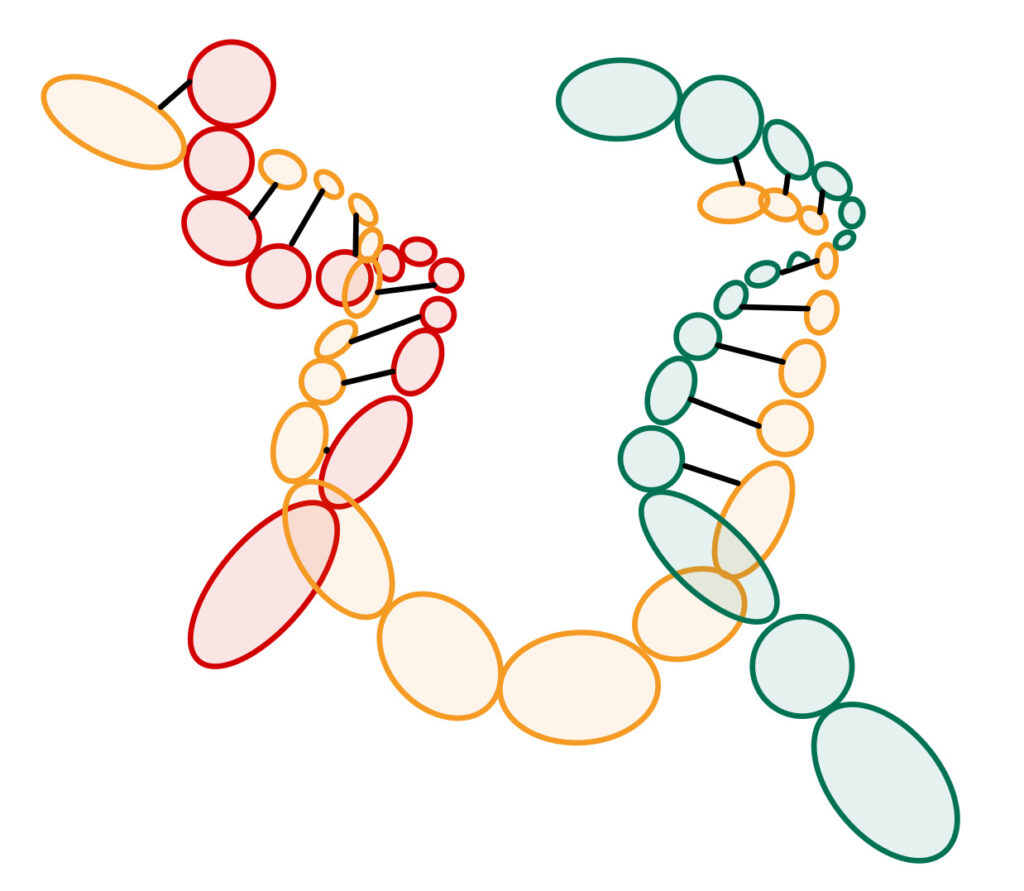
DNA Origami
BY CHRISTIAN KIM
For decades, scientists have been looking for a suitable scaffold to help build tiny 3-D structures such as nanomaterials. One possible solution to this is DNA. Many of us can probably recall the characteristic double helix shape of DNA from biology class. In nature, DNA is limited to this double helix shape, greatly limiting its potential as a scaffold for other structures. However, since the 1980s, scientists have been experimenting with DNA, and have found ways to allow it to take on a wide variety of shapes, such as the one seen below, in a process known as DNA Origami.1
DNA Origami works by using short fragments of DNA called Oligos (formally known as DNA Oligonucleotides) and stitching them together in immobile branch “junctions”, such as the 4 branch junction pictured above, known as a Holliday Junction. This is accomplished by using short, single stranded DNAs called “staples” to help fold longer Oligos into these junctions. Then, by connecting oligos and junctions a wide variety of complex 3D structures can be formed, much like how KNex sticks and connectors can be joined to make various projects. The creation of 3D structures is further enhanced by decades of research into the mechanisms behind folding, and the creation of more complex junctions, such 3, 6, and even 12 point junctions.1
With all this progress in DNA Origami techniques, it is now possible to employ DNA in a vast range of applications that require nano-scale 3D specificity. Possible applications include everything from catalysis to drug delivery and even bioimaging. However, one of the most promising applications of DNA Origami is as a “scaffold” on which to build or manipulate other nanomaterials. One such recent application, from Shanghai Jiao Tong University, used DNA Origami to align Carbon Nanotubes (CNTs).3
Since their discovery in the early 1990’s, carbon nanotubes (CNTs) have been touted as a “cure all” in many material science and engineering fields. Carbon nanotubes—a one atom thick sheet of carbon rolled into a cylinder—boast many impressive properties such as extremely high electrical and thermal conductivity, incredible strength, and the inherent versatility of carbon. However, in order to harness many of these special properties, CNTs need to be aligned in a parallel fashion.4
From its inception, carbon nanotube research has been plagued by the naturally random orientation of the nanotubes and until recently, there has been no scalable way to align CNTs. Research as early as 2010 proposed DNA Origami as a possible solution. Unfortunately, in its natural state, the DNA was only able to align CNTs at very low rates, making it unusable in industry. However, by using DNA segments dispersed on gold nanoparticles as an interface, the Zuo Lab was able to achieve a 5-fold increase in aligned CNTs, creating a method that may be scalable to mass production.3
This 5-fold increase was achieved by using a combination of two types of DNA strands, gold nanoparticles, and a main aligning DNA Origami substrate. The first type “wraps” the CNTs through hydrophobic interactions between the DNA and the CNT surface. This forms DNA-CNT complexes that can then be further manipulated by connecting the second type of DNA strand to a “linker region” on the wrapping DNA. The second type of DNA scaffold is composed of spherical segments of DNA called spherical nucleic acids (or SNAs), dispersed onto gold nanoparticles. These SNAs interact with the DNA-CNT complex through the linker region on one side of the nanoparticle, and to the main DNA Origami surface on the other, as diagrammed below. This interaction places the nanoparticle-DNA-CNT complex in specific locations, and in specific orientations on the DNA Origami surface to align the CNTs in one direction.3
The usage of SNA coated nanoparticles as an interface between DNA-CNT complexes and the DNA Origami surface allowed for more efficient interactions between DNA and CNTs, resulting in 20 strands/100 nm2, compared to the 5 strands / 100 nm2 shown in previous experiments without the nanoparticles present.3 While this 5-fold increase in alignment efficiency is very promising, much more work needs to be done before CNTs can be brought to market. However, this success shows that DNA origami can be an effective tool in the creation of nanomaterials. Whatever the future of carbon nanotubes looks like, DNA could play a major role.
References
1. Hong, F.; Zhang, F.; Liu, Y.; Yan, H. DNA Origami: Scaffolds for Creating Higher Order Structures. Chemical Reviews 2017 117(20), 12584-12640. 10.1021/acs.chemrev.6b00825
2. Swarup Dey, C. F.; Gothelf, K.V.; Li, J.; Lin, C.; Liu, L.; Liu, N.; Nijenhuis, M. A. D.; Saccà, B.; Simmel, F. C.; Yan, H.; Zhan, P. DNA Origami. Nat Rev Methods Primers 2021, 13.
3. Zhang, Y.; Mao, X.; Li, F.; Li, M.; Jing, X.; Ge, Z.; Wang, L.; Liu, K.; Zhang, H.; Fan, C.; Zuo, X. Nanoparticle-Assisted Alignment of Carbon Nanotubes on DNA Origami. Angewandte Chemie 2020 59(20), 4892-4896.
4. Scoville, C.; Cole, R.; Hogg, J.; Farooque, O.; Russell, A. Carbon Nanotubes. Washington University CS.
